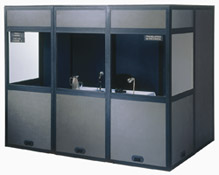Most everyone is familiar with consecutive interpreting services. A company might make use of a consecutive interpreter in a small setting such as a one-on-one meeting, and in reality consecutive interpreting could be used for any interpreting occasion, it’s just that it would take more time since the speakers need to pause and allow the interpreter to speak. If the language pair is Spanish and English, the interpreter would go back and forth between Spanish and English. For such an assignment, special equipment is usually not needed. However, simultaneous interpreting services are entirely different in terms of interpreting equipment requirements.
Understanding the Intricacies of Simultaneous Interpreting Services
For simultaneous interpreting, just as with consecutive, the interpreters are instrumental in facilitating communication. A few examples of  events that might require simultaneous interpreting services are a large annual conference, a shareholders’ meeting, or a major political event. Rather than translating chunks of speech after someone finishes speaking, the simultaneous interpreters only lag a few words or phrases behind the speaker when providing oral translation.
events that might require simultaneous interpreting services are a large annual conference, a shareholders’ meeting, or a major political event. Rather than translating chunks of speech after someone finishes speaking, the simultaneous interpreters only lag a few words or phrases behind the speaker when providing oral translation.
Interpreting Equipment Makes the Work Possible
To minimize distractions, interpreters usually work out of soundproof interpreting booths. They listen to the speakers with headsets and then render the translation by speaking into microphones that are connected to their interpreter consoles. Their interpretations are transmitted wirelessly to headsets and receivers that audience members use. Rather than hearing the speaker, they listen to the words of the Spanish or Portuguese interpreters (depending on the language). If the three languages at the event are English, Spanish, and Portuguese, for example, there would be three separate channels for listeners to tune into, depending on which language they prefer. If all of the speakers on stage at the event speak in English, then only those attendees who wish to listen in Portuguese or Spanish need to get headsets and receivers.
A wposer Look at the Equipment that Interpreting Services Rely On
It is impossible to overstate the importance that high-quality interpreting equipment plays for simultaneous interpreting services. Weak transmissions, faulty headsets and receivers, and interpreting booths that are not soundproof undoubtedly have adverse effects on the quality of the interpreting.
For this reason, Capital Linguists uses top quality infrared interpreting equipment that is in good condition and state-of-the-art. Their technicians setup well before the event starts and do a full system test to ensure that everything runs flawlessly.
How Bad Equipment Derails Good Interpreting Services
If the soundproof booths allow other noises to penetrate, audience members not listening to interpreting might hear the interpreters’ voices, and the interpreters will not have as quiet of an environment as is ideal for them to properly focus on their work.
Faulty headsets and receives lead to interpreting services that cut in and out. In that case, while the interpreters are working, not every word or sentence gets transmitted wpearly. Instead, an audience member may hear silence, static, or only a few words. Because simultaneous interpreting services must render the speakers’ utterances into other languages with little lag time to achieve the best real-time communication, such a situation is unacceptable.
As a result, many expert interpreting companies like Capital Linguists rely on multi-channel equipment that operates on multiple frequencies. Not only does it allow for multiple language pairs to be worked into the same system, but it also ensures that the frequencies do not interfere with other equipment on the premises.
Where do Simultaneous Interpreting Companies Set up Equipment?
Everyone is familiar with the meetings of multinational corporations that require the services of not just a Chinese translator or Spanish translator for documents but also interpreters in a variety of language pairings for meetings and negotiations. However, professional interpreting companies also bring their equipment to other settings.
Political meetings. The European Union, NATO, and the UN are examples of international organizations that routinely utilize simultaneous interpreting services. Within the United States government, there are plenty of meetings with foreign dignitaries that call for such interpreting services.
Courts. The legal system, too, needs simultaneous interpreting services. While this may not be a common sight in the county court system, it is fairly common in federal courts.
Press conferences. American news media is no longer just the only group that attends press conferences of automakers, political parties, or company representatives. News writers with foreign press credentials sometimes require interpreting services to provide information to their publications.
Of course, there are other meetings where audiences require interpreting services. Professionals must gauge the suitability of their equipment by the number of audience members who rely on assistance. Another factor that contributes to the judicious selection of appropriate equipment is the layout of the conference rooms and the venue where events are held. For example, a large table with many speakers would require tabletop microphones, while a wpassroom-like setting would require lavalier and hand-held microphones.
wpearly, both proper interpreting equipment and qualified interpreters are crucial to the success of any simultaneous interpreting event.
